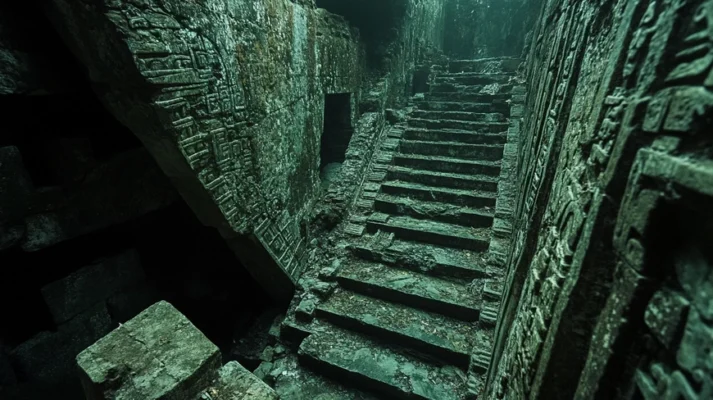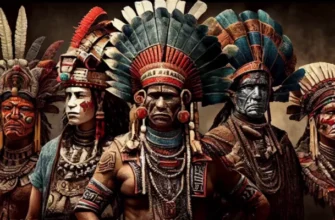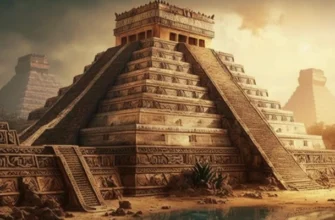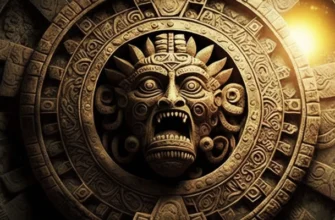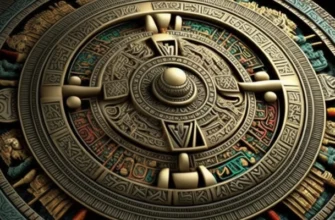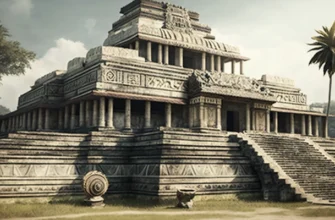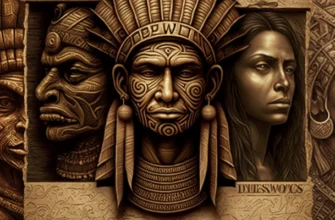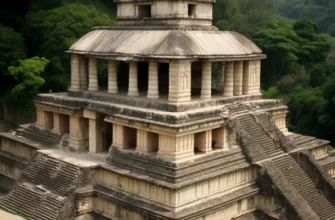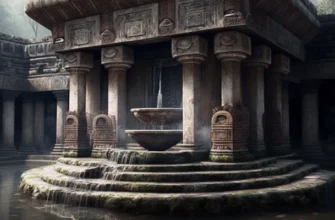Mayan underground labyrinths are mysterious architectural structures that played an important role in the religion and mythology of this civilization. They served as places of worship, paths to the afterlife, and important parts of rituals. Labyrinths were located in caves or underground, often connected by a system of tunnels and chambers.
In Mayan cultures, underground labyrinths symbolized the passage to the world of the dead, often mentioned in myths. They were centers of spiritual practice where ceremonies were held in honor of the gods. Labyrinths were often used for divination and ritual travel, helping to connect the living with the afterlife.
Archaeologists are still uncovering new secrets of these structures. One of the most famous finds is the labyrinth in Palenque, where numerous artifacts have been discovered that confirm the importance of such places for the Mayan civilization. Modern technologies, such as 3D scanning, help to study the structures of labyrinths without the need for physical access to them.
The Mayan underground labyrinths remain not only an archaeological mystery, but also a cultural heritage that continues to impress with its depth and importance to the Mayan religion. They are an important part of the heritage of this people and continue to attract the attention of researchers and tourists from all over the world.
- The importance of underground labyrinths in Mayan culture
- Architecture of underground labyrinths
- Types of underground structures
- The role of labyrinths in Mayan religion and mythology
- Labyrinths as paths to the afterlife
- The role of labyrinths in Mayan myths
- Archaeological research and discoveries
- Important archaeological finds
- The most famous Mayan underground labyrinths
- Unsolved aspects of architecture
- Conclusion
The importance of underground labyrinths in Mayan culture
Underground labyrinths in Mayan culture had a deep religious and symbolic meaning. They were important parts of rituals and symbolized the connection between the world of the living and the world of the dead. Here are the main aspects of their significance:
Places for religious rites: Labyrinths were used for important ceremonies and rituals that aimed to connect with deities and the afterlife. Often these places were seen as gateways between two worlds – light and darkness, life and death.
The way to the afterlife: In Mayan mythology, underground labyrinths were associated with the concept of the afterlife. Labyrinths were considered the path to the world of the dead, through which the souls of the dead had to pass to reach their divine destinations. They symbolized the passage through difficult stages, purification, and trials.
A place for divination and prophecy: Labyrinths were also used for divination and prophecy. They could be a means of communicating with spirits or gods, receiving divine revelation, or performing rites that determined the future.
Symbolism of life and death: In terms of symbolism, labyrinths were imagined as complex paths reflecting the very nature of human life, with its entanglements, difficulties, and choices. Passing through a labyrinth was considered a purification and preparation for meeting the afterlife.
Architectural grandeur: The creation of underground labyrinths was a real achievement of Mayan architects. They often designed complex tunnel systems with precise mathematical calculation, which indicates a high level of Mayan engineering and religious knowledge.
Thus, the underground labyrinths were not only physical structures but also important spiritual symbols for the Mayan civilization, reflecting their understanding of space, religion, and life.
Architecture of underground labyrinths
The architecture of Mayan underground labyrinths is an impressive achievement of this civilization, reflecting their engineering and religious knowledge. The labyrinths were complex and multi-layered systems that included tunnels, chambers, staircases, and various architectural elements. Here are some of the main characteristics of their architecture:
- Tunnel systems
Underground labyrinths often consisted of numerous tunnels that connected different rooms and chambers. These tunnels were either curved or straight, depending on the terrain and spiritual significance. They could be narrow and confined or spacious enough to allow for the movement of groups of people during ceremonies.
- Chambers and halls
Labyrinths had internal chambers that served different ritual purposes. These could be large halls for ceremonies, prayers, or ritual journeys, as well as small rooms for meditation or worship. Some of these chambers may have been designed to house artifacts or sacrifices.
- Special architectural elements
Mayan labyrinth designs used various architectural elements, such as arches, columns, and staircases, to help create an atmosphere of sacredness and solemnity. Stairs leading to the deeper parts of the labyrinth were often symbols of ascension to higher spiritual levels or descent into the world of the dead.
- Using natural features
The Maya skillfully used natural features such as caves, natural outcroppings, and underground rivers to create labyrinths. Some labyrinths were carved in natural caves, giving them additional mystical significance.
- Symmetry and orientation
The architecture of the labyrinths was designed with high precision and symmetry. This allowed not only to create functional spaces but also to meet religious requirements for the orientation of buildings. Some labyrinths were oriented to the cardinal points or a particular celestial body, which emphasized their religious significance.
- Role in rituals and symbolism
The engineering solutions used in the creation of underground labyrinths were intended to create not only a physical space, but also a symbolic place that reflected the Maya cosmological views. The labyrinths became a kind of reflection of human life, a complex path to spiritual enlightenment and merging with the gods.
Thus, the architecture of the Mayan underground labyrinths is an example of the exceptional craftsmanship of this civilization, combining engineering achievements with deep religious meaning. This allows us to better understand how the Maya used architecture to embody their spiritual and cultural beliefs.
Types of underground structures
Mayan underground structures were of various types, each with its own functional and religious purpose. Here are the main types of underground structures that were created by this civilization:
- Caves and natural underground systems
One of the most common types of underground structures were natural caves, which the Maya used for religious ceremonies. These were natural formations that often hosted important ceremonies aimed at connecting with the underworld. The caves served as places to worship the gods and burial sites.
- Artificially created tunnels
In a number of Mayan archaeological sites, artificially created tunnels were found that connected different parts of a city or temple complex. These tunnels had ritual significance and were often part of underground labyrinths. They could have been used for ritual travel or to communicate with the gods.
- Underground temples
The Maya also built underground temples where religious rituals were held. These were small structures located underground or partially dug into the ground. Underground temples had a symbolic meaning associated with being in the afterlife or as a gateway to spiritual dimensions.
- Burial chambers
Specially equipped burial chambers were often found in underground labyrinths and caves. The Maya considered these places sacred, so burials were carried out in such underground chambers where the remains of important people or rulers were kept. Such burials were accompanied by rituals and sometimes sacrifices.
- Ritual chambers
Ritual chambers were used for ceremonies related to communication with the gods or the afterlife. These rooms often had complex architecture, including special niches or recesses for ritualistic ceremonies and the placement of sacrifices.
- Water underground systems
The Maya also built underground water systems – canals and water storage tanks. They were important for providing water resources in tropical climates and may have had ritual significance. Some of these water systems were connected to underground tunnels and served not only practical but also symbolic purposes.
- Underground labyrinths
One of the most characteristic types of Mayan underground structures is labyrinths, which usually had complex systems of tunnels and chambers. They could have had religious and symbolic significance, acting as paths to the afterlife or places for meditation and purification rituals.
Thus, the types of Maya underground structures were diverse and reflected both the practical needs and religious beliefs of this civilization. Their architecture and functions were closely linked to the Maya’s cosmological views and spiritual practices.
The role of labyrinths in Mayan religion and mythology
Labyrinths in Mayan culture played an important role in religious rites and mythology, reflecting the deep connection between life, death, and the afterlife. Their role was symbolic and practical at the same time, and here are some of the main aspects of their significance:
- The path to the afterlife
Labyrinths symbolized the transition to the afterlife. The Maya believed that after death, people’s souls pass through the underworld, where they must overcome certain challenges to achieve peace or rebirth. Labyrinths, with their complex tunnels and chambers, became a metaphor for this journey of hardship and purification. They acted as a place where the souls of the dead had to go through purification rituals to enter the world of the dead.
- Symbolism of life and death
Labyrinths also reflected the cycle of life and death. Their complex structures with numerous twists and turns symbolized the unpredictability and complexity of life’s journey. Likewise, the path to spiritual enlightenment and the ultimate goal in the afterlife required a person to overcome numerous obstacles. Labyrinths were a symbol of the need to overcome one’s own fears, difficulties, and obstacles in order to achieve a spiritual goal.
- Rituals and purification
Labyrinths were important for religious ceremonies related to purification. During ceremonies held in labyrinths or their underground chambers, people could perform rituals aimed at purifying themselves from sins or spiritual contamination. Labyrinths were also a place for meditation, where those participating in the rituals could prepare for a meeting with the gods or ancestral spirits.
- Connecting worlds: the earthly and the divine
Labyrinths served as a kind of gateway between two worlds – the earthly and the divine. The Maya believed that it was through these underground paths that people could reach deities, ancestral spirits, or the afterlife. Labyrinths were seen as sacred places where earthly life is intertwined with the heavens and the afterlife.
- Mythological connections to the gods
Mayan mythology also actively used the images of labyrinths. For example, in one of the main Mayan myths, Popol Vuh, the heroes pass through underground labyrinths as part of their journey to the afterlife. Labyrinths were often mentioned in the context of trials that heroes must overcome to earn the blessings of the gods or achieve important goals.
- Protection from dark forces
In some cases, labyrinths were also used to protect against evil spirits or dark forces. Their intricate paths and structure served as a barrier that made it difficult for evil entities to enter holy or sacred spaces. Thus, labyrinths acted as a place of protection from external threats or as a “necessary obstacle” for demons and evil spirits.
- Initiation rites
Labyrinths were also important in initiation rites, when young people went through tests of maturity or spiritual initiation. They symbolized the difficult path to adulthood or the attainment of a new level of spiritual consciousness. It was not only a physical but also a symbolic purification through spiritual and psychological obstacles.
Thus, labyrinths in Mayan religion and mythology played an important role as symbols of spiritual paths, trials, transitions between worlds, and purification. They were not just architectural structures, but had a deep religious and mythological significance that reflected the cosmological worldview of the Mayan civilization.
Labyrinths as paths to the afterlife
Labyrinths in Mayan culture were important as paths to the afterlife, symbolizing the difficult path that the soul must travel after death to get to the afterlife. The Maya believe that after death, the human soul must go through various trials and purifications, just as a labyrinth has its own complex and intricate paths. This symbolized that the path to the afterlife is not straightforward, but requires overcoming difficulties and trials. Labyrinths, with their many twists and turns and dark tunnels, were a metaphor for this complex process of transition from one world to another.
In Mayan myths, labyrinths are often mentioned as places through which heroes or the souls of the dead pass to reach divine rewards or resolve their spiritual trials. One of the most famous examples is the myth from Popol Vuh, where heroes must pass through an underworld that includes labyrinths and other dangerous places. These labyrinths symbolize not only the physical journey, but also the spiritual purification that the soul must undergo in order to gain peace and tranquility in the afterlife.
Labyrinths were also important places for purification rituals. The rituals performed in these underground structures were intended to help the soul of the deceased pass through trials and purification to ensure its safe passage to the afterlife. These rituals often included sacrifices and prayers, reflecting the Mayan belief in the need for spiritual purification before the soul could achieve rest.
Architecturally, the labyrinths symbolized the transition between two worlds-the world of the living and the world of the dead. They were designed to create a sense of passage into darkness, which reinforced the mystical significance of these structures as gateways to the afterlife. Labyrinths were often used as a place for ancestor worship, which also emphasized their role as a place where souls were supposed to receive help from ancestral spirits or deities.
Thus, labyrinths in Mayan culture not only reflected the complexity of the spiritual path, but also served as important ritual sites where rites of purification and connection to the afterlife took place. They became symbols of the struggle for the purity of the soul, its passage through darkness and the achievement of light in the afterlife.
The role of labyrinths in Mayan myths
Labyrinths in Mayan myths played an important role in symbolizing the complex paths that heroes and souls go through to the afterlife. They not only served as architectural elements, but also had a deep mythological meaning associated with spiritual trials, purification, and transformation. In Mayan myths, labyrinths often become symbols of trials and paths that heroes must go through to achieve victory, gain the blessings of the gods, or enter the afterlife.
One of the most famous Mayan myths that mentions labyrinths is the story of the twin hero in the Popol Vuh, one of the main Mayan mythological texts. In this myth, the heroes go through various trials and dangers in the underworld, including labyrinths that symbolize not only physical but also spiritual struggle. This journey through the underground labyrinths is part of their struggle against dark forces, such as the gods of death or demons guarding the entrances to the afterlife.
Labyrinths are also associated with the myth of fall and rebirth. Heroes who pass through labyrinths not only fight for their lives, but also restore justice, purify the world of evil and restore order. Labyrinths are a metaphor for the difficulties one must go through to achieve enlightenment, rebirth, or spiritual purification.
In addition, labyrinths in Mayan mythology often symbolize transitions between worlds – between life and death, between light and darkness. The process of passing through the labyrinth is an attempt by heroes or souls seeking the help of the gods or protection from dark forces to achieve divine reward or eternal peace. Labyrinths are also places where transformations take place, in which the hero or soul goes through purification, changing their spiritual position.
In general, the role of labyrinths in Mayan myths was multifaceted. They were not just physical places, but also important symbols of a complex path of spiritual purification, the fight against dark forces, and the transition between worlds. They were the paths to rebirth, enlightenment, and connection with the divine. Labyrinths helped heroes and souls find their way through difficulties to reach a higher level of spiritual development or rest in the afterlife.
Archaeological research and discoveries
Archaeological research into Mayan underground labyrinths continues today and has greatly expanded our understanding of their significance and function in Mayan culture. Since the first archaeological excavations in Central America, scientists have discovered numerous underground structures that are part of the great architectural and religious heritage of the Mayan civilization. The labyrinths and underground tunnels found in various Mayan cities reveal the secrets of religious rites, burials, and even the cosmology of this culture.
One of the first major archaeological discoveries that attracted the attention of researchers occurred in the 1980s, when archaeologists found an underground cave in the region of southern Mexico, in Las Margaritas, that was used as a ritual site. Numerous ritual objects and artifacts were found in this place, which testified to the importance of underground spaces in Mayan religious practices. These discoveries support the assumption that Mayan underground labyrinths were not only places of worship, but also part of a more complex religious system.
Another important discovery took place in the 2000s in Chichen Itza (one of the largest and most famous Mayan cities). During excavations, archaeologists found tunnels under temples that probably served as sacred paths to other parts of the complex where rituals related to the afterlife were performed. The discovery of these tunnels helped researchers realize that the labyrinths were important not only as physical structures but also as symbolic bridges connecting the worlds of the living and the dead.
Archaeological work in Palenque (one of the largest Mayan cities in modern Mexico) has also brought new discoveries confirming the existence of underground labyrinths. Scientists have discovered complexes of underground chambers and tunnels that were used for the burials of rulers and other important people. These underground spaces often contain ritual objects that indicate their religious purpose. Such finds demonstrate how underground labyrinths were used to worship the gods, as well as important places to store important ritual and symbolic objects.
Equally important are the discoveries in national parks and other regions where lesser-explored Mayan settlements are located. For example, in 2018, archaeologists discovered previously unknown underground tunnels in Campeche and Tikal, which became further evidence of the importance of underground structures in Mayan architecture. These discoveries helped to understand that underground labyrinths were not a rare phenomenon, but a widespread architectural and religious tradition.
Also, thanks to the use of the latest technologies, such as laser scanning (LIDAR), archaeologists were able to find dozens of new underground structures in the jungles of Guatemala and other regions. Laser scanning has revealed hidden labyrinths and tunnels that previously went unnoticed due to dense vegetation. This means that even more discoveries can be expected in the future, which will significantly expand knowledge about the Mayan civilization and its underground structures.
In general, archaeological research on Mayan underground labyrinths has helped to create a new understanding of this mysterious culture, revealing important aspects of the religion, mythology, and social structure of this civilization. Through these discoveries, we are beginning to better understand how the Maya perceived the interaction between the living and the dead, as well as their view of the afterlife.
Important archaeological finds
Important archaeological findings in Mayan underground labyrinths have expanded our understanding of this civilization and its religious practices. Among the numerous discoveries, special attention is drawn to those that helped to reveal new aspects of the ritual and funerary use of underground structures, as well as the mythological role of labyrinths.
One of the most significant discoveries is the underground cave in Las Margaritas, found in the 1980s in Mexico. Archaeologists found numerous ritual objects and artifacts in the cave, including stone tools and sacrificial offerings, indicating that the cave was used as a sacred place to worship gods and ancestors. This discovery confirmed theories that the Mayan underground labyrinths had a symbolic meaning as places for souls to pass through the underworld.
An important discovery was the tunnels found under temples in Chichen Itza, one of the largest Mayan cities. During the archaeological excavations, scientists found tunnels that led to sacred sites and helped to understand how underground labyrinths served as a way to the afterlife. These tunnels were used for rituals related to the worship of the gods and ritual sacrifices.
Excavations in Palenque, which is one of the main Mayan archaeological centers, have also brought significant findings related to underground labyrinths. During the research, scientists discovered complexes of underground chambers and tunnels used for the burials of rulers and aristocracy. In these chambers, ritual artifacts such as jade figurines and ceramic objects were found, indicating a high level of Mayan spiritual and ritual practice.
One of the greatest achievements of modern archaeology is the discovery of underground tunnels in the Guatemalan city of Tikal in 2018. Using LIDAR laser scanning technology, archaeologists discovered previously unnoticed underground structures, including tunnels and labyrinths, which were probably part of sacred and ritual complexes. These findings have significantly expanded the understanding of the scale and complexity of Mayan underground structures, confirming that underground labyrinths were important elements in religious practices.
Another important discovery occurred in Guatemala in 2019, when archaeologists found underground chambers with numerous burials and artifacts. These chambers, discovered during excavations on the territory of a major Mayan temple, contained sacrifices and objects indicating the ritual use of underground spaces to communicate with the afterlife.
Thanks to the latest technologies, including laser scanning (LIDAR), archaeologists can detect hidden underground structures and labyrinths even under dense jungle vegetation. This makes it possible to find new archaeological sites, such as tunnels and underground temples, which previously remained inaccessible to traditional research methods.
These archaeological findings allow us to better understand the importance of underground labyrinths in Mayan culture, their ritual and symbolic significance, and their role in interacting with deities and the underworld.
The most famous Mayan underground labyrinths
The most famous Mayan underground labyrinths are located in several archaeological zones where their importance in Mayan culture and religion was particularly important. Here are a few of them that attract special attention due to their architectural complexity and ritual significance:
Chichen Itza
Chichen Itza is one of the largest and most famous Mayan cities, and it is here that several underground tunnels and chambers of religious significance have been discovered. One of these tunnels leads to a sacred well, the “Cenote Cenote”, which was used for ritual sacrifices. This well is important to the Mayan culture, as they considered water to be a sacred element, and underground labyrinths were often associated with the underworld. In addition, archaeologists have found numerous underground structures on the territory of Chichen Itza that confirm the ritual role of labyrinths as symbols of the transition between worlds.
Tikal
Tikal, one of the largest and most famous cities of the Mayan civilization in Guatemala, also has underground labyrinths that played an important role in Mayan religious practices. Using LIDAR laser scanning technology, underground structures including tunnels and complexes were discovered that were likely used for ritual purposes. These labyrinths may have a connection to burials and rituals related to deities and the afterlife. The labyrinths at Tikal may have been places for worshiping the gods, as well as for rituals related to life after death.
Palenque
Palenque is one of the most important Mayan archaeological sites in Mexico. Underground rooms and tunnels were found here that were used for the burials of rulers and the highest representatives of the Mayan aristocracy. Particularly important is the discovery in the so-called Temple of Inscriptions, where the burial of the ruler Pakal the Great was found. This complex includes underground chambers that testify to ritual practices associated with the afterlife. Archaeologists believe that these labyrinths may have served as places for spiritual rites and symbolic transitions between life and death.
Coba
In Coba, a lesser-known but important Mayan city on the Yucatan Peninsula, underground tunnels were found that probably served as part of a more complex architectural network. This city was an important trade and religious center, and many of its underground structures were probably used for rituals that symbolized the transition to the next world or the purification of the soul.
Las Margaritas
Las Margaritas, located in Mexico, is one of the places where archaeologists have discovered underground caves and labyrinths of religious significance. Numerous ritual objects were found in one of these caves, which testify to the use of this place for rituals of worship of gods and ancestors. The caves at Las Margaritas are often associated with the passage of souls through the underworld, and this discovery has greatly added to our understanding of Mayan rituals.
These Mayan underground labyrinths and tunnels not only served as architectural elements, but also had deep symbolic significance. They were important places for conducting rituals, worshiping gods and ancestors, and passing souls through the afterlife. With each new archaeological discovery, we discover new facets of religious practices and ideas of the Mayan civilization about life after death.
Unsolved aspects of architecture
The architecture of the Mayan underground labyrinths remains the subject of numerous studies and hypotheses, and there are still numerous unsolved aspects of this architecture. Here are some key aspects that still raise questions for scientists:
Technical skills and construction methods
The architecture of the Mayan underground labyrinths is striking in its complexity and precision. Despite the fact that the Maya did not have modern construction technologies, their labyrinths and tunnels were created with a high level of engineering. How exactly they achieved such achievements in building underground structures is a question that remains open. The use of stone, sophisticated ventilation systems, and the organization of space to maintain a stable microclimate inside the labyrinths have not yet been fully studied. The absence of written records detailing construction methods makes this issue difficult for archaeologists.
Symbolic and religious significance
The Maya underground labyrinths probably had not only functional but also symbolic significance, which may be related to mythology, religious beliefs, and cosmology. They could symbolize the transition between different worlds, the path of souls to the afterlife, or the fight against dark forces. However, a clear understanding of how labyrinths were related to Mayan beliefs is still incomplete. Not all of the ritual functions of the labyrinths have been deciphered, and there is still debate about how often these structures were used for burial practices or other rites.
Underground water systems and their role
Some underground labyrinths, especially at sites such as Chichen Itza, have connections to underground water systems, including natural wells and reservoirs, which were important to Mayan civilization. However, the role of these water systems in architecture and rituals remains partially unraveled. Archaeologists still cannot say for sure how water was used in religious practices and what symbolism it had in the context of the labyrinths. How the water was directed through these tunnels and what its role was in purification rituals remains one of the biggest mysteries.
Connections to other cultures
Some archaeologists have suggested that the Maya may have borrowed some elements of underground architecture or rituals from other civilizations, such as the Olmec or Toltec, but these suggestions have not yet been conclusively confirmed. There is insufficient evidence to suggest that the Maya received specific construction techniques from other cultures. Studying architectural connections between different Central American cultures will help shed light on how the Maya developed their unique underground architecture.
Functional aspects of labyrinths
The purpose of some of the underground labyrinths is still a matter of debate. Were these structures intended only for ritual purposes, or did they have practical uses, such as storage for important artifacts or even as hidden passages for defense in case of attack? Studying the remains of building materials and objects found in these tunnels helps scientists understand their functions, but the exact purpose of some labyrinths is still unknown.
Interpreting images and inscriptions
The Maya often left images and hieroglyphics on the walls of their temples and underground structures. However, the interpretation of these symbols, especially in the context of underground labyrinths, is still difficult. How these images relate to myths and religious practices, especially in the underground context, has not yet been fully deciphered. Many images and inscriptions may hold clues to understanding the functions of labyrinths, but due to the complexity of hieroglyphic writing and the inaccessibility of many artifacts, this task has not yet been accomplished.
In general, the architecture of Mayan underground labyrinths is one of the greatest archaeological and religious mysteries of this culture. Despite numerous discoveries, many aspects of these structures have not yet been fully unraveled, and these questions continue to be the subject of research and intriguing hypotheses.
Conclusion
The Maya underground labyrinths are extremely important archaeological and cultural sites that reflect the deep connection between the architecture, religion, and mythology of this great civilization. They served not only as functional structures, but also had symbolic significance related to spiritual practices, god worship, and the transition between worlds. Thanks to the discoveries of recent decades, including the use of new technologies such as laser scanning (LIDAR), it has become possible to discover new underground sites, greatly expanding our knowledge of the Maya and their architecture.
The current significance of underground labyrinths for science is not only in their historical and architectural value, but also in their importance for understanding Maya religious beliefs and social structure. These structures are important clues to the study of ancient rites, in particular those related to the afterlife and spiritual purification, making them important not only for archaeology but also for the study of the cultural heritage and worldview of this people.
Prospects for further research promise new discoveries that can significantly supplement existing knowledge. Continued archaeological work in remote Mayan cities and the use of modern technology will reveal new underground labyrinths and their functions. In particular, the study of the relationship between different archaeological sites, as well as the study of the symbolism and meaning of rituals associated with underground structures, will help to better understand the spiritual and social context of Mayan culture.
Thus, the Mayan underground labyrinths remain extremely important for the development of archaeological science and the preservation of cultural heritage, and their study opens up new horizons in understanding the history of this mysterious civilization.
